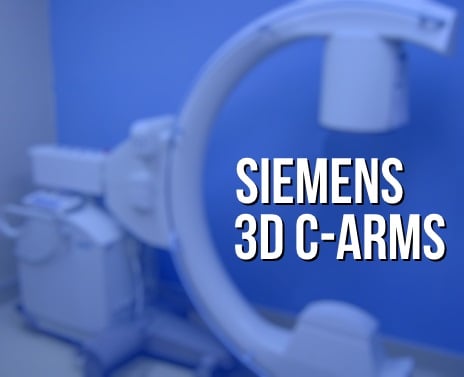
Updated: March 29, 2021 : 1 min read
3D C-Arm Comparison: Siemens Iso-C vs. Orbic 3D
If you're looking into 3D C-arms, you're probably already aware of the advantages they provide in terms of time savings, radiation dose reduction, and eliminating the need for patient repositioning.
If so, your next questions probably revolve around figuring out which 3D system is best for you. Read on to learn more details through a comparison of two of the more popular models from one of the top manufacturers.
If not, click here to learn some background on how 3D C-arms make this possible.
Iso-C vs. Orbic 3D
| Iso-C | Orbic 3D | |
| Design/Footprint | almost identical | almost identical |
| Power | 40-110 kV, mA to 23, mAs to 150 | same ranges |
| Resolution | 512 x 512 | 1k x 1k |
| Date of Manufacture | 1999-2004 | 2004-present |
| Software Platform | Memoskop | Syngo |
| Monitors | CRT | flatscreen |
| Data Transfer Media | CD (USB upgrade optional) | USB |
The Question of Cost
A patient-ready, refurbished Siemens Iso-C 3D, delivered and installed with a 1-year warranty averages around $39,000. Coming from Block Imaging, there is an additional option to rent for a minimum of 6 months at $3,500 per month. This is a great way to "try it before you buy it" and, should you decide to keep the system, 50% of your rental payments is applied as credit toward a purchase.
The same package with a Siemens Orbic 3D runs around $65,000. In this case, monthly payments for the rental option are $4,500 with a 9-month minimum and the same credit-toward-purchase opportunity.
So, Which Is Better?
Ultimately, a facility seeking the advantages of 3D C-arm technology would be well served by either of these machines, but there are areas where each of them shines:

Where the Iso-C Wins: The biggest advantage of the Iso-C is its significantly lower cost. As an older model, this fact simply comes with the territory. The mobility, degree of rotation, and power output are all the same as the Orbic, but for less money. For a facility that wants 3D capability but sees only moderate C-arm traffic or, perhaps, needs to be more budget-conscious, this could be an excellent fit.
Where the Orbic 3D Wins: In terms of technology and image clarity, the Orbic is the clear frontrunner. The development of the Syngo software platform brought about improvements over many aspects of the older Memoskop platform. Additionally, the 1k x 1k resolution and flatscreen monitors allow for an appreciable increase in clarity. If your facility has the budget and volume needs for it, the advantages of the Orbic could make it well worth the extra capital investment.

Chris Sharrock
Chris Sharrock is the Vice President of Healthcare Solutions at Block Imaging. Each day Chris sets out to provide the best equipment, parts, and service solutions for healthcare facilities across the world. Outside of work Chris enjoys playing in a band, and spending time at the lake with his family.




